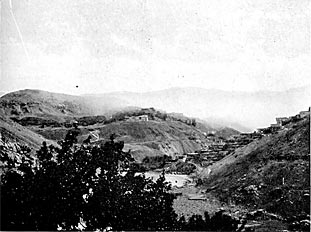
|
DIYÂRBEKR TO KONIA
June 4—July 1
THE frontier between the Arabic and the Turkish-speaking peoples is not sharply defined. Through the southern parts of the Kurdish hills it is common to find men acquainted with one or both languages in addition to their native Kurdish; among the Christians of the Tûr 'Abdîn a knowledge of Syriac is not rare; in Diyârbekr, where there is a considerable Arab population, Arabic, Turkish and Kurdish are spoken about equally, but north of Diyârbekr Arabic ceases to be heard, and as we journeyed along the road from Kharpût to Malatiyah, Kurdish died out also. Fattûh, in addition to many other qualifications for travel, speaks Turkish fluently, though in a manner peculiar to himself; the muleteers who were with me had some knowledge of the language, and I have enough to wish that I had more of that singularly beautiful and flexible tongue. Thus equipped we set out to make our way across Taurus and Anti-Taurus on to the Anatolian plateau.
---------------------------
we spent the night somewhat uneasily by reason of certain wedding festivities which were there in / p.328 / progress. Not only did the merry-makers keep up their rejoicings until close upon dawn, but the inhabitants of a neighbouring village judged the occasion to be propitious for mule-lifting, and were driven off with rifle shots. Peace was restored by daybreak, and the marriage procession conveying the bride to her husband's house set off to the strains of fife and drum. We passed it upon the road, a motley crowd, mounted and afoot. The bride was enveloped in a silken cloak of vivid magenta, which will not, I fear, be needed again for many a long day, if her opportunities for the wearing of finery may be measured by the aspect of her future home, for a more poverty-stricken collection of hovels than the bridegroom's village it would be difficult to picture. We left her in her brief glory to take up her daily task of preventing her husband's roof from falling about her ears, and rode on to the hill of Arghana, a bold spur of the Taurus mountains, with a village perched among its crags. I sent the baggage animals along the carriage road and climbed with a zaptieh to the village, and thence by a steep path to the Armenian monastery of the Virgin, which stands on the summit of the rocks.1
---------------------------
We were rewarded by a magnificent view and by a pleasant talk with the prior who informed me, as I drank his excellent coffee, that the monastery was founded in the first century of the Christian era, a tradition which calls for weightier confirmation than any which he advanced. Be that as it may, the existing house must have been largely rebuilt in the Middle Ages, perhaps towards the fourteenth century—I hazard this date on the evidence supplied by the decoration of the church which had the character of Mohammadan work of about that period. We led our horses down the north side of the hill, by a stony
As far as Malatiyah we followed the high road which led us at first across a fertile plain celebrated for its gardens ever since the days of Ammianus Marcellinus. Outside the village of Tarmûr1
1 Our itinerary was as follows: Diyârbekr, 7; Shilbeh, 8; Uch Keui, 9.5; Dereh Gechid Chai, a deep valley once noted for brigands, 10.45; Tolek, a village on the opposite side of this valley, 11. Here followed 35 minutes' halt during which the caravan caught us up and passed us, but we came up with it again before we reached Kara Khân Chai, a small river, at 1 o'clock. We got to Tarmûr at 2.45. I give these hours since Kiepert's map is frequently mistaken as to relative distances.
---------------------------
1 The day's march was Tarmûr, 6; Kayden Keui, 6.30; Shawa Keui, 6.50 (both these villages lay about three-quarters of an hour to the right of the road); Tulkhum, a mile to the left of the road by a big mound, 7.10; we climbed a low ridge and dropped into a little plain in which we crossed a stream at 8.15; Kadi Keui to the right, 8.30; road up to Arghana, 9; monastery, 10.10-10.55; crossed the Ma'den Chai by Kalender Koprüsi at 1; Khân above Arghana Ma'den, 3; the caravan had arrived a few minutes before us.
---------------------------
[ Illustrations opposite p.328 ]

|
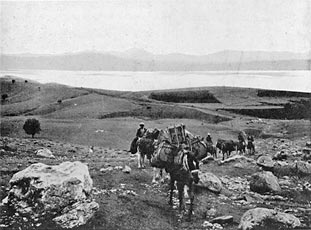
|
[ Illustrations opposite p.329 ]
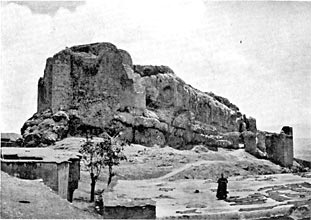
|
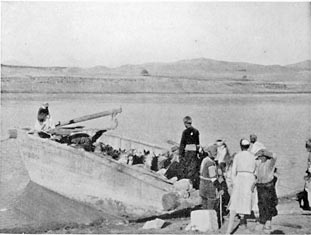
|
/ KHARPÛT p.329 / path that ran between bramble hedges enclosing fruit gardens, rejoined the carriage road and crossed the Ma'den Chai, which is the local name for the main arm of the Tigris, by a bridge near Kalender Khân. We had now fairly entered into the mountains, and our road took us over high bare ridges and down again to the Ma'den Chai at the village of Arghana Ma'den, the mines of Arghana. On a shelf of the opposite hill-side the smoke drifted perpetually from the smelting furnaces of the richest copper mines in Turkey (Fig.210). The metal, smelted on the site, is cast into disks, two of which go to a camel load, and sent across the hills to Diyârbekr and Cæsarea, Sivâs and Tokat. The valley of the Ma'dan Chai, where the village lies, is so narrow that it offers no camping-ground; we lodged, therefore, in a charming khân above the village by the water's edge—but for the fact that it was innocent of furniture I could have fancied myself in an English country inn by the side of a rushing trout stream. The rain fell heavily in the night, and we rode for the greater part of the next day through an alternate drizzle and downpour, and were unable to determine which we enjoyed the most. The river cuts here through a deep rocky gorge, and the road climbs up by the side of the stream. The mists, clinging to the precipitous slopes, added to the sombre grandeur of a pass which opened at its upper end on to an exquisite little fertile plain, set like a jewel among the hills. Through its cornfields the infant Tigris, a rippling brook, wandered from willow clump to willow clump; we parted from it two hours from its source, and set our faces towards the hills which divide it from its mightier brother, the Euphrates. At their foot lies the Little Lake, Göljik, encircled by peaks, of which the northern slopes were white with snow patches (Fig. 211). It is slightly brackish, and its waters have no outlet. We turned aside from the carriage road and took a bridle path along the northern side of the lake, and up the hills beyond it. Before we reached the crest of the slopes we struck the road again and by it crossed the water parting, and saw below us the rich and smiling plain of Kharpût bounded by mountains, through which wound the silver streak of the / p.330 / Euphrates. We camped that night at the foot of the pass in the Armenian village of Keghvank, our tents being advantageously placed in a grove of mulberry-trees, loaded with ripe fruit.1
---------------------------
Kharpût, or rather the lower town, Mezreh,2
---------------------------
which is the seat of government of the vilayet of Ma'mûret el 'Azîz, lies three hours from Keghvank. The plain between is exceedingly fertile; it is scattered over with villages about half of which are inhabited by Armenians, who suffered cruelly in the massacres of 1895. At Kezerik, half-an-hour to the south-east of Mezreh, two finely-cut inscriptions, commemorating the expedition of Domitius Corbulo in
---------------------------
On an inner wall, not far from the gate, there are traces of an Arabic inscription, together with two stones carved in relief, the one bearing a lion and the other a ram, memorials, I make no doubt, of the Ortukid rule. The walls are of many periods of building. The masonry of one of the eastern towers is laid in alternate stripes of red and white stone. The eastern side of the hill drops steeply into a deep valley filled with houses which are terraced one above the other. Here there is a Jacobite church of ancient origin, its plan repeating the old scheme of the parochial church of the Tûr 'Abdîn. The priest assured me that it dated from the first century, and in proof of his assertion showed me a couple of curious oil paintings, a Crucifixion and a Virgin and Child, Byzantine in type, so far as I could make out through the dust of ages.2
---------------------------
My tents were pitched on the plain near Mezreh. There in the evening I received the Vâlî, a cheerful Cretan, and the Mu'âvin Vâlî,3
---------------------------
and after they had departed, several other visitors. Their conversation left me groping my way through the intricate labyrinths of the Oriental mind, and even more bewildered than usual. Kharpût and Mezreh and the villages of the plain had felt yet more sharply than Diyârbekr and the Tûr 'Abdîn the wave of panic that had emanated from Cilicia. Three days after the first outbreak at Adana, the Kurdish peasants had trooped into the Chris- / p.332 / tian villages and announced their intention to kill, while in Mezreh the Vâlî was besieged by demands that he should give the signal for massacre. To his credit be it recorded that he held out against these appeals, though the abject terror of the Armenians did much to increase the danger of the situation. When the news of 'Abdu'l Hamîd's deposition reached the vilayet, the agitation went out like a candle in the wind; the Kurds returned peaceably to their houses, and the fears of the Christians were allayed. This was strange enough, but that which followed was stranger still. The district had suffered during the spring from lack of rain and the drought became at length so serious that the whole harvest was threatened. The leading mullah of Mezreh called upon the people to assemble in a neighbouring village, where there was a much-respected Mohammadan shrine, that they might raise a common supplication for rain. The population answered his call to a man; Christian and Moslem, who but five weeks before had with difficulty been restrained from leaping at each other's throats, stood side by side and listened to the sermon which the mullah delivered to them. All, said he, were brothers, all were children of one God, all alike were in danger of perishing from the drought, and it behoved all to pray together for the beneficent rain which would save them from famine. His eloquence reduced the assembled audience to tears, and for three days their united orisons rose to heaven. And then the miracle came to pass. The rain fell abundantly, that same rain over which we had rejoiced in the Tigris gorge, without knowing that we owed it to the prayers of the Moslems and Christians of Kharpût, nor yet how many fevers it was assuaging, more fatal than the sun-fever in our veins; for it was admitted that this most fortunate coincidence would do more to bring about amity than the fall of many sultans.
---------------------------
It chanced that Fattûh and I and a zaptieh were on ahead, and as we went we fell into talk. Now Fattûh is a Catholic Armenian, and in the old days we have experienced many a difficulty over his teskereh, owing to the ominous word / p.334 / Armenian which is inscribed upon it. At the end of the last journey he had vowed that he would change his faith, which does not sit very heavy upon him — Fattûh being a philosopher touching the finer distinctions of creed — and I now asked him whether he had carried out this determination.
/ MALATIYAH p.335 /
When the camel-train had passed I said:
---------------------------
The ferry is a couple of hours further up stream, but we reached it late in the afternoon and were too weary to cross that night. We pitched our tents on the bank — it was our last Euphrates camp — opposite the village and great mound of Iz Oglu.
---------------------------
/ p.336 / The road was planted with mulberry-trees that dropped their ripe fruit at our feet; the swelling slopes were deep in corn, and water-loving poplars stood in the meadows at the valley bottoms — I do not think that we broke the record of travel upon this stage: there were too many temptations urging us to loiter. Modern Malatiyah occupies the site of Azbuzu, a village which was once the summer quarters of the parent city. In 1838, during the war between Turkey and Egypt, Azbuzu became the head-quarters of the Turkish general, Hâfiz Pasha. Old Malatiyah, which is situated about two hours to the north-west, was at that time in great part destroyed for the enlarging of Azbuzu, and has since lain deserted and almost uninhabited. Moltke, who joined the Turkish army in 1838 and remained with it for a year, describes the wonderful luxuriance of the gardens of Azbuzu in his enchanting volume of letters, the most delightful book that has ever been written about Turkey, with the sole exception of Eothen. The gardens are no less exquisite now than they were in his time, and as we rode down the hill-side the houses were scarcely to be seen through their screen of fruit-trees. Even upon a nearer view the walnuts and mulberries are far more striking than the buildings of Malatiyah, which are constructed, as Moltke says, out of exactly the same material as that with which the swallows make their nests. We camped in the midst of poppy-fields by one of the many streams for which Malatiyah is famous, and I spent the afternoon exploring the town, but could find nothing of interest in it, except some Hittite reliefs which had been brought from Arslân Tepeh.1
---------------------------
I had already determined to visit old Malatiyah, and the sight of these stones sent me round by the mound from which they had come. We rode for half-an-hour through gardens to Ordasu, itself buried in gardens, and thence to a ruined monastery, a quarter of an hour up the hill-side. A small chapel has been patched together in the north aisle of the original church. Slabs carved with Latin crosses, or
1 The day's march was as follows: Khân of Arghana Ma'den, 6.20; Khân of Pünoz, at upper end of gorge, 9.40 (the village of Pünoz lies up a rocky valley to the right); Kâsim Khân, at further side of plain, 10.55-11.30—there is no village here; Göljik, 11.55; Shabyan, a small village near the water parting, 1.40; Keghvank, 4.
---------------------------
2 Mezreh is perhaps Ptolemy's Mazara (ed. Mûller, p. 945), and it bears the same name in the Peutinger Tables.
---------------------------
Kharpût is set upon the summit of the hills beyond Mezreh. The castle, standing upon the highest crag, guards a shallow ravine wherein is stretched the greater part of the town, but the houses climb up on to the rocky headlands overhanging the plain and, from below, the mountain seems to be crowned with a series of fortresses (Fig. 212). The streets are so narrow that a cart can hardly pass along the cobbled ways; very silent and peaceful they seemed, the shops heaped with cherries, the cool breezes stirring the vine tendrils that wreathed together overhead. The castle, for all its frowning walls and bastions, is nothing but a heap of ruins within. I looked in vain for the dungeons in which Sukmân, the son of the Turkman officer Ortuk, founder of the Ortukid dynasties, / KHARPÛT p.331 / imprisoned Baldwin of Edessa and Jocelyn of Courtney in the early years of the twelfth century. The Crusaders, gathering together their forces, seized the fortress in 1123 and held it until Balak, Ortuk's grandson, recaptured it and threw the garrison over the battlemented rock into the plain below.1
1 The garrison consisted of 65 men and 80 beautiful ladies, a proportion of the sexes which may have contributed to Balak's victory.
---------------------------
2 Kharpût has been identified with Carcathicerta, which was the royal city of Sophene, according to Strabo.
---------------------------
3 Since the outbreak of 1895 a Christian governor has been appointed in all vilayets which contain a large proportion of Armenians. The Mu'âvin Vâlîs are nominally co-rulers with their Moslem colleagues, but report, I know not with how much justice, credits them with little influence and less initiative.
---------------------------
I sat long into the night and gazed upon the shattered crags of Kharpût and the hollow plain, clothed in abundance of fruits, and sheltered by its ring of noble hills. What is it that leads to massacre? whence does that sudden frenzy spring, whither vanish? Like a tornado it bursts over the / MASSACRE p.333 / peaceful earth, blots out the daily life of town and village, destroys, uproots and slays—and passes. My thoughts were still busy with these unanswerable problems when we rode upon our way next morning. One of my muleteers was a Moslem, a hajjî, a Mecca pilgrim. I had known him for many years and he had served me well during months of hard travel. When the road was long he had not wearied; when the sun was hot he had not complained; when the wind blew cold he drew more closely about him the duffle coat which I had given him in Aleppo, and every evening after the tents were pitched and the horses picketed, I had seen him building up the fire under the big rice-pot and stirring the savoury mess on which my camp was to sup. To-day as I looked into his simple honest face, I wondered what unexpected ferocity lay behind its familiar wrinkles.
"Hâjj 'Amr," I said, "in the day of slaughter, would you kill me?"
"My lady, no," he replied, "not you. I have eaten your bread."
"Would you kill Fattûh and Selîm and Jûsef?" I asked.
"No, no," said he, "not them. We are brothers."
"But other Christians you would slay?"
"Eh wallah!" he answered; "in the day of slaughter."
I ceased my questionings and rode on, but the subject was to come up again. It happened in this manner.
We had journeyed over the plain to Khân Keui and climbed on to a low spur of the hills. Having crossed it, we rode down a long valley with high hills on either hand.1
1 Mezreh, 6.5; Khân Keui, 9.25; Tell Mahmûd, left of road, 9.45; Chaghullah, left of road, 9.55; Sapolar (left), 10.5; Harnik (right), 10.20; Melekjân (about a mile to the right), 10.35; Cholak Ushagi, where there is a khân, 11-11.45. Here we crossed a ridge into a valley which runs down to the Euphrates. Tutli Keui (left), 2.5; over another ridge and down to Kömür Khân at 3.35; Iz Oglu, 5.45.
---------------------------
"Effendim," he replied, "two years ago, when I returned to Aleppo, I told the bishop that I would become Brotestant or Latin (Protestant or Roman Catholic). And he argued with me and said he would send a priest to pray with me. But I said No, for I and my family are Brotestant."
"And are you a Protestant ?" said I.
"God knows," replied Fattûh. "On my teskereh I am still written down a Catholic Armenian, but that I cannot be, for I refused to let the priest come into my house to pray. Therefore I belong to no religion but the religion of God."
"We all belong to that religion," said I.
"True, wallah," said the zaptieh.
Presently there came up the road towards us a train of loaded camels.
"These are men of Kaisarîyeh," said Fattûh. "I know them by their dress." And as the first string of camels drew near, he shouted to the man sitting half-asleep upon the leading animal: "Are you from the port, the port of Beilân ?"
"Evvet, evvet," he answered drowsily, and his body rocked with the long rocking of the camel's stride as they plodded past.
"Nasl Kirk Khân?" cried Fattûh. "How does Kirk Khân?"
Kirk Khân is a Christian village at the foot of the Beilân Pass, between Aleppo and Alexandretta.
The next cameleer had come up with his string and he answered the question.
"The giaour are all killed," he answered, taking Fattûh for a Moslem.
"And how are the houses, the houses of the giaour?" Fattûh called out. The leader of the next string answered—
"They are all burnt."
"Praise God," said Fattûh, and the zaptieh laughed.
"Why did you call the people of Kirk Khân infidels?"
"Because the camel-driver called them so," Fattûh replied.
"And why did you praise God?"
"Effendim, they praised God when they saw Kirk Khân in ashes, and they rejoiced to tell the tale — what else should I say?" He rode on silently for a few minutes, and then he added: "All the men of Kirk Khân were my friends. Every time I drove my carriage from Aleppo to Alexandretta, I stopped to eat with them, and they, when they were in Aleppo, came to my house. Now they are dead — God have mercy on them."
His sorrowful acceptance of an outrage which the Western mind, accustomed to regard the protecting of human life as the first obligation of society, refused to contemplate, revealed to me the magnitude of the gulf which I had been attempting to bridge, and as I followed the channel of Fattûh's thought, I saw Fate, in the likeness of a camel-train, moving, slow and heavy-footed, towards the inevitable goal.
Our road climbed over a bluff and dropped again into a ravine at the lower end of which stands Kömür Khân, an old, red-roofed caravanserai, stately in decay. Near to it flows the Murad Su, which is the Euphrates, and though we were now far from its Mesopotamian reaches, it was already a great river whose waters had received the tribute of many snows. Below Kömür Khân it enters a narrow gorge where the hills fall sheer into the water, and above the khân, carved upon a slab of rock, a Vannic inscription bears witness to the high antiquity of the road.1
1 It is probably the ancient caravan road from Cæsarea and Ephesus to Babylon.
---------------------------
The next day's ride took us over hill and dale to Malatiyah.2
2 Iz Oglu (on the west bank of the Murad Su, 8; Masnik, 10.15; a big chiflik of which I do not know the name, 12–12.30; we climbed a long hill, reaching the summit at 2.15, and got to Malatiyah at 2.45.
---------------------------
1 They had been published, but not very satisfactorily. I gave my photographs to Mr. Hogarth, who published them in the Annals of Archæology and Anthropology, Vol. II. No. 4.
---------------------------
[ Illustrations opposite p.336 ]
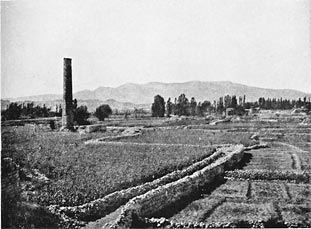
|
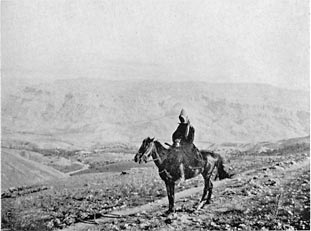
|
[ Illustration opposite p.337 ]
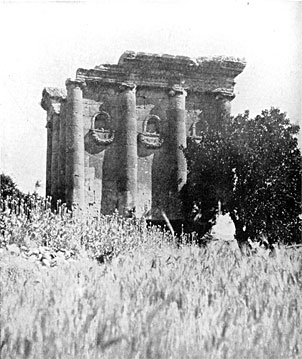
|
/ MALATIYAH p.337 / with the Greek cross encircled by a victor's wreath, lay about among the ruins or were built into the walls, and upon the piers of the old nave the capitals were roughly carved with acanthus. None of this work seemed to me to be earlier than the eighth or ninth centuries, but I saw in the grass-grown court finely-moulded column bases which were of earlier date. They may have been brought from the city of Melitene, which was the forerunner of old Malatiyah.1
---------------------------
An hour's ride from the monastery stands the big mound of Arslân Tepeh surrounded by gardens and poppy-fields. Without the evidence of the reliefs it might have been conjectured to represent a Hittite city. The wide fertile valley in which it is placed, the backing of hills, the open plain stretched out beyond it, combine to make Arslân Tepeh one of the typical sites chosen by the old people, and excavation might prove it to be the mother-city of the townships, represented by mounds, which were scattered over the lower ground. From Arslân Tepeh we rode for fifty minutes to Old Malatiyah, which has moved rapidly towards complete decay since it was deserted seventy years ago (Fig. 214). The walls and bastions are dropping piecemeal into the poppy-fields that fill the moat; of the streets little or nothing remains: the ruined mosques and tall / p.338 / minarets rise out of a sea of silvery poppy flowers. The Ulu Jâmi' is still used for prayer, but its door was locked and the key was not to be procured. I climbed by its carved and half-ruined gateway on to the roof, and peering through the windows of the dome, saw that the interior was beautifully decorated with tiles and inscriptions. A rich store of fine Mohammadan work remains to be studied there.
---------------------------
Elemenjik is a great breeding farm, the property of the late Sultan, who owned most of the pasture lands about Malatiyah. The population were in some distress at the prospect of a change of masters and the abolition of the privileges attached to a royal estate, and the government was confronted with a difficult problem with regard to the disposition of these domains. Few private persons could afford to pay the full price for the large breeding stables on the Sultan's farms, and the properties will lose much of their value when they lose the military guard that watched over the security of the royal mares. The solitude that will be a drawback when Elemenjik comes into the market, was a delightful advantage to our camping-ground, and the people of Kharpût must have been at their prayers again, for the rain fell in refreshing torrents and, clearing away, left the broad plain and the unexplored peaks of the Dersîm mountains shining in the sunset.
---------------------------
When he had exhibited all that was to be seen, he handed me over to one of his colleagues, who was to accompany us to Derendeh, with the parting injunction that he was to guide me to every ruin in the hills. "This khânum," he observed, "likes ruins."
1 Melitene does not appear to have been in existence in Strabo's time for he says that there were no towns in the fruitful plain, but only strongholds upon the mountains (Bk. XII. ii. 6). Procopius states that it was raised by Trajan to the dignity of a city, whereas before it had been nothing but a square fortification on low ground (Palestine Pilgrims' Text Society Edition, p. 82). Diocletian made it the capital of Armenia Secunda (Ramsay: Historical Geography, p. 313); it was the centre of the military roads guarding the frontiers of the Roman empire towards the Euphrates, and the standing camp of the XII Legion, Fulminata (id. p. 55). With this increase of importance it outgrew, according to Procopius, its former limits, so that the people built over the plain "their churches, the dwellings of their magistrates, the market-place and the shops of their merchants, the streets, porticoes, baths and theatres, and all the other ornaments of a large city." Melitene was thus composed mostly of suburbs until Justinian surrounded it with a wall. There must, however, have been cities in the plain, of which Strabo knew nothing, long before Trajan's time, as is proved by existing mounds, and Pliny seems to have preserved a dim memory of these when he speaks of Melitene as having been founded by Semiramis (Bk. VI. ch. iii.).
---------------------------
It was a five hours' ride across the plain to Elemenjik, where our camp was pitched.1
1 Malatiyah Eskishehr, 9.45; Khâtûnyeh (a quarter of a mile to the left), 10.20; a chiflik (name unknown), 11.45–12.15; Saman Keui, a village near a big mound, 12.55. In a graveyard near here I noticed two fragments of round columns. At 1.25 we crossed a deep valley and saw the village of Shehna Khân about half-a-mile to the right; Elemenjik, 3.10. Not all these villages are marked in Keipert and some are wrongly placed. There is cultivation round each village, but the plain between is usually untilled.
---------------------------
Next morning we passed by another of the Sultan's farms, nestled among poplar-trees in the midst of carefully hedged fields, and in three hours we came to Arga, where we called a halt while we changed zaptiehs. I was well pleased at the delay, for it gave me opportunity to examine some elementary excavations which had been carried out by the Turkish / ELEMENJIK p.339 / government. They had uncovered the foundations of a church with a tesselated marble pavement, fragments of round columns and moulded bases of excellent workmanship; that it was indeed a church I took on trust from the zaptieh, who acted as showman, for the aims of the excavators had not included the revelation of a plan; but the slabs carved with crosses bore out the official view.
1
1 Arga has been identified with Arca, where there was a Roman station (Arca was also the seat of a bishopric: Ramsay, Hist. Geog., p. 314), and with Ptolemy's Arcala (ed. Mûller, p.888). The great road mentioned by Strabo which led from Babylon to Ephesus, crossing the Euphrates at Tomisa-Iz Oglu, passed through Arca (according to Sir W. Ramsay's suggestion, op. cit., p. 273) and ran through Dandaxina and Osdara to Arabissus and thence through the mountains to Cæsarea. Kiepert places Dandaxina immediately to the south of the Tokhma Su and Osdara in the same latitude; Ramsay puts both places further south, and Sterritt's evidence supports Ramsay's conclusions. Between Arga and Ekrek my route did not touch the Roman road as laid down by Ramsay, but ran further to the north, and where I crossed the mountains, between Osmandedeli and 'Azîzîyeh, I saw no trace of an ancient road, nor can I think that wheeled traffic can ever have followed that line. Ainsworth travelled down the Tokhma Su from Görün to Derendeh, but he came over the Akcheh Dâgh between Derendeh and Arga, whereas I crossed it further east from Arga to Ozan. Ainsworth observes that there were never more than two roads from Derendeh to Malatiyah, one following the line he took, and one the valley of the Tokhma Su down to the plain (Travels and Researches, Vol. I. p. 247). I do not feel inclined to dispute that opinion, for though I found a third way from Malatiyah to Derendeh, it cannot be called a road. The mouldings and capitals which I saw at Arga pointed to a date not later than the sixth century.
---------------------------
"Effendim, olour," replied his interlocutor, "it shall be."
But it was not. Perhaps there are no ruins where we crossed the Akcheh Dâgh, or perhaps in the excitement of the road the zaptieh forgot them as completely as I did. Our path would have done credit to the most sensational of journeys. It led us over wild and rocky hills and down into gorges incredibly deep and narrow, and when we stopped to draw breath at the bottom of one of these breakneck descents, / p.340 / we saw the track in front of us climbing mercilessly up the opposite precipice. We came to the bottom of the first valley at 11.45, about an hour from Arga; Deveh Deresi is its name. At the top of the next ridge the splendid gorge of the Levandi Chai opened at our feet. With many warning cries to the baggage animals and much tugging at the taut bridles of our own mounts (for these passages had to be performed on foot) we reached the stream at 1.20 near to the Kurdish village of Levandiler. A steep climb brought us in another hour to the high village of Chatagh; a quarter of an hour beyond it we topped the pass and rode down by easy gradients to Levent. Here, surrounded by magnificent rocky hills, we pitched camp. Our hosts were men of the Kizil Bâsh, a sect whose head-quarters are in the Dersîm. Their creed, which is much contemned [lit.] by the Moslems—and not in words alone—is said to waver between Paganism, Christianity, Manichæanism and Shî'ism, touched with some memories of ancient Anatolian cults. I did not attempt to unravel these mysteries during the evening I spent at Levent, but contented myself with inviting the headmen of the village to a coffee-party, on which simple human basis relations of the most cordial nature were established. The night was sharply cold, and we set out next morning, with numb fingers, to scramble down into the valley below Levent and up to the opposite ridge, which we reached in one hour. Above us towered the rocky plateau of the Kal'ah Dâgh, flanked on every side by cliffs, and below lay the wide and fertile valley of the Tokhma Su (Fig. 215). The caravan pursued its way westward, but I turned east, by Kurd Keui and Saman, and touched the river at Ozan, four hours from Levent, where my zaptieh had promised me a ruin. "Ishté bu," said the headman of the village, pointing across the poppy-fields, "here it is;" and he turned away to gather us a dish of ripe mulberries, while I stood in amazement before the Ionic columns and carved garlands of a little tomb that might have graced the Appian Way (Figs. 216 and 217). There are no inscriptions upon it, nor anything to tell whose bones were laid within the vaulted chamber; I sent a greeting across the ages to the shade of him who had brought
[ Illustrations opposite p.340 ]
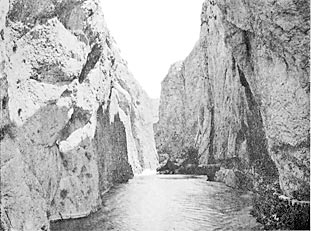
|
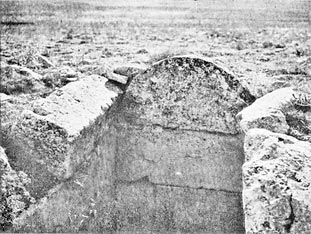
|
[ Illustrations opposite p.341 ]
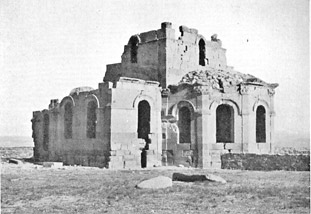
|
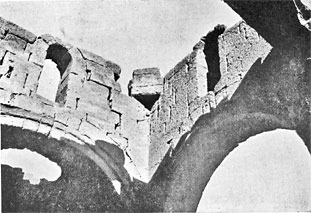
|
/ OZAN p.341 / into this remote and inaccessible valley the arts of the West, and journeyed on.
In four hours' ride, by an easy path up the right bank of the Tokhma Su, we reached our camp, pitched near the village of Kötü Kal'ah, which takes its name from a small ruined fort on the rock above it,1
---------------------------
and another four hours brought us next morning to Derendeh.2
---------------------------
the town is scattered among gardens for close upon an hour's ride along the valley. Towards the upper end a ruined castle stands upon a bold promontory of rock overhanging the stream.3
---------------------------
A staircase, hewn in the precipice, gave the defenders access to the water; on the further side the hill slopes down more gently, and the ruins of a former Derendeh lie about its foot. We marched three
FIG. 217.—OZAN, TOMB.
---------------------------
We pitched camp above the village in a flowery meadow, through which hurried the Tokhma Su, a tiny flashing brook. On a rocky point above us were the ruins of a fort with a Greek cross in a wreath cut upon the fallen lintel of its door.
---------------------------
As soon as we had climbed out of the valley of Osmândedelî we found ourselves on a wide upland, swept by cold airs and ringed about with mountains. The wheat was scarcely up, the grass sodden with newly melted snow, the peaks all white. In the midst of these fields lay Küpek Euren, a small hamlet near a mound which was covered with the building stones of an earlier time, while upon the slopes that closed the western end of the plateau was the village of Bey Punar. Having passed the latter, we climbed into the hills by a shallow gorge down which flowed the head-waters of the Tokhma Su. Our way was decked with flowers. Daphne and androsace, veronica and dianthus grew among the rocks, and purple primulas edged the channel of the stream. The gullies were still full of snow. So we came to the water parting, 2,040 to 2,070 metres above sea-level, according to Kiepert, and bidding farewell to the last source of the Mesopotamian rivers, rode down into the basin of the Mediterranean. The long gently-sloping meadows were rich in grass, but no flocks grazed there, and no summer villages were to be seen among the juniper-bushes. The lonely beauty of these alpine pastures, where nature spreads out her fairest bounty, e beata si gode, fell upon us like a benison, and once again I offered up praise to all mountains. The water-runnels gathered together into a small clear stream which rippled away from its birthplace in the green hollows and plunged, we following it, into a pine-clad valley. The path grew steeper and more rocky as we descended, the valley narrower, until there was no place left free from pine and berberis and juniper but the boulder-stewn bed of the river. At length we were able to pull our horses up an exceedingly steep track through the pine-woods, by which we emerged on to a grassy hill-side. Here by good fortune we found a party of Cir- / p.344 / cassians, who were hauling their bullock wagons, heavily loaded with timber, over ways which we reckoned to be hard going even for our baggage animals. They directed us to Boran Dereh Keui. Before we had gone far we rounded a spur and the snowy peaks of Mount Argæus swam into our ken, set in the midst of the Anatolian plateau.
---------------------------
From 'Azîzîyeh we turned our faces to / TOMARZA p.345 / Mount Argæus and travelled along a well-laid road to Ekrek.1
---------------------------
Among the hills at some distance to the right of the road stands the castle of Mahmûd Ghâzî, magnificently placed upon a peak. My zaptieh told me that in spite of its name it was a Christian fortress, for he had seen crosses carved upon the lintels, and only the distaste for further excursions that follows upon long stages of mountain travel, prevented me from going up to it. I have a shrewd suspicion that it must be the Tsamandos of the Byzantine historians.2
---------------------------
Ekrek, where we pitched camp, is built in the bottom of one of the deep valleys which are typical of the district about Argæus. The lava with which the plain is covered forms a sharp cliff on either lip of these gorges, and in places the formation of the volcanic beds is so distinct that the lava can be seen lying like a solid pavement upon the soil, broken off at the edges of the valley and scattered down the slopes in huge slabs. Before I got into camp I turned off to see the small ruined church of no very great interest, and within the town there are several larger churches, all remodelled by the Armenian inhabitants.3
---------------------------
The early Christian architecture of the eastern side of Cappadocia was unknown to me except from books, and finding myself in St. Basil's own country, I seized the opportunity of visiting some of the buildings which sprang up with the monastic impulse which he implanted. Instead of making straight for Cæsarea I rode next day under the slopes of the Köleteh Dâgh to the ruins of the Panagia above the village of Köpekli,4
---------------------------
/ p.345 / and so to Tomarza, where there is one of the finest / p.346 / of the Cappadocian ruins (Fig. 220). Both these buildings exhibit the Anatolian type of the domed cruciform, which was already familiar to me, but the decorative details, the engaged pilasters upon the outer walls, the elaborate mouldings, the string-courses carved over doors and windows, are not to be found in the churches that lie further to the west. I sat that night in the Armenian monastery where I was lodged, and pondered over the artistic tradition which these things revealed, and the mingling of occidental with oriental themes which they implied. Not far to the south-east of Tomarza stands among the hills the famous shrine of Comana, sacred to the goddess Ma. With its ancient Asiatic cult and its temples constructed or reconstructed in the Imperial period, Comana was one of the great meeting-places of the culture of East and West; its buildings must have exercised a strong influence over the architecture of eastern Cappadocia, and I determined to seek among its ruins evidences of the age that had preceded the early Christian.
1 Ozan, 10.30; Mullah 'Alî Shehr, 11.5-40; Polat Ushagha, 12.35; Tozeli, some distance to the left, 12.55; a ruined khân marked by Kiepert, 1.20. Here we saw up a valley to the north the village of Palanga, marked by Kiepert. Above the khân the river flows through a gorge, and on the rocks above it are the ruins of a small fort, which we reached at 2.20; Kötü Kal'ah village, 2.45.
---------------------------
2 We passed upon the way only one village, Mügdeh, where we crossed the Tokhma Su. Kiepert has suggested that Derendeh may represent the site of ancient Dalanda; for objections to this view, see Ramsay, op. cit., p. 309.
---------------------------
3 The existing ruins are probably mediæval. Ainsworth (Travels and Researches, Vol. I. p.246) reports an illegible inscription, presumably Arabic or Turkish,over the gate. I do not remember to have seen it. The fortress of Tarandah is mentioned as early as the year A.D. 702, when it was in the hands of a Moslem garrison. In the ninth century it was held by the Paulicians, a sect of Eastern Christians whose beliefs were mingled with Manichæanism. (Le Strange: Lands of the Eastern Caliphate, p.120.)
---------------------------
hours further and camped at Yazi Keui, upon the grassy margin of the stream. The bare valley, with its ribbon of cultivation along the water's edge, gave us delightful travelling, but of archæological interest there was nothing to be found, and when a native of Yazi Keui brought us informa- / p.342 / tion of ruins at some distance from our path, I engaged him joyfully to conduct us thither on the following morning. He led us into the hills to the north of the river by a fairly good road (it is the direct caravan road from Sivâs to Albistân, and much frequented) and on to a wide pasturage, an hour and a half from Yazi Keui. The snows of Nurshak Dagh, south-east of Albistân, were visible from the huts of this alpine yaila. At its northern end we found a considerable quantity of shapeless ruins, mere heaps of unsquared stones, and among them three small tombs, half-buried in the earth (Fig. 219). They varied from 2 to 2.50 m. in length, by 1.20 to 2.20 m. in width, and were built of carefully dressed stones. Each had a door in one of the short sides, and each had been covered by a stone vault. In another hour and a half we came down to the Tokhma valley opposite the village of Tikmin; we passed through Telin and reached the khân of Görün in two hours more. There we halted to pick up fresh zaptiehs, and were greeted by the news that the zaptiehs were not ready and that the caravan had gone on unescorted. I had no mind to be parted from my tents upon an unknown road, and, abandoning my intention of visiting a Hittite inscription in the gorge above Görün, I posted after the muleteers with Jûsef at my heels. The path leaves the valley here and crosses some high ground, upon which, after an hour's hard riding, we caught up the caravan and were ourselves caught up, while we paused to lunch, by the zaptiehs. After we had passed a large chiflik belonging to the Sultan, we descended once more into the valley of the Tokhma Su at Osmândedelî.
1

1 Görün, 12; summit of hill, 1.15 (but we had ridden considerably faster than our usual pace); Kevak Euren, to the left, 3.10; chiflik, 4.30; Osmândedelî, 5.
---------------------------
We had now before us the roughest stage of our journey, for we had reached the hills that part the waters tributary to the Euphrates, from those that are tributary to the Saihûn— / OSMANDEDELÎ p.343 / the Persian Gulf from the Mediterranean. I cannot recommend the way we took across them, except for the beauty of the high and desolate pass. 1
1 Osmândedelî, 6.25; Kaindîjeh, 7.10; there is a better road from here, but it makes a long circuit by Günesh and Parenk, and I declined to take it. Küpek Euren, 8.20; Bey Punar, 9.45; water parting, 11.10; Boran Dereh Keui, 5.10.
---------------------------
Boran Dereh Keui is a Muhâjir village, that is to say, it is peopled by Circassian immigrants from the Caucasus. They have filled the valley of the Zamantî Su, and though they are not liked by the indigenous population, their coming has raised very sensibly the level of civilization. Forty years ago the Zamantî valley was innocent of any settled habitation; the nomad Avshars drove their flocks up to it in the summer, sowed scanty crops, and left before the first winter snows. Now it is all under the plough, and the Circassian villages, with their osier beds and neat vegetable gardens, are scattered thickly along it. Nomad life dies out in a cultivated country, and the Avshars are settling into villages, though their houses are not so well built, nor their gardens so well kept as those of the Circassians. The chief town of the district is 'Azîzîyeh. There we changed zaptiehs, and I sat in the konak while the necessary arrangements were being made and drank coffee with the officials. Presently there appeared one who was half a negro and told me his tale in the strong, guttural Arabic of the desert. He was a native of the Hejâz; he had wandered up into this country before there were any villages in it and had remained as a merchant.
"It is very beautiful here," said I.
"Yes," said he, "but the desert is different. I have not seen it for forty years." And I understood what was in his heart.
Behind the konak a plentiful spring bursts out from under the cliffs. I walked up to it and saw men digging up old walls in quest of cut stones. Fragments of columns and rude mouldings pointed to the former presence of a church, and perhaps an earlier shrine hallowed, in true Anatolian fashion, the abundant source.1
1 'Azîzîyeh is the ancient Ariarathia and its foundation dates from the second or third century B.C. : Ramsay, op. cit., p. 310.
---------------------------
1 'Azîzîyeh, 10; Emergal, an Avshar village on the left, 12; Takhtalî, on the right across the river, 12.20; Kizil Khân, 1.35. (See Ramsay, op. cit., p. 298. It is perhaps Strabo's Erpa "on the road to Melitene.") Bazaar Euren, 2.25. Between Kizil Khân and Bazaar Euren there is a small khân with ruins near to it, among them a carved door jamb. Ekrek, 5.
---------------------------
2 Ramsay, op. cit., p. 289, places Tsamandos at 'Azîzîyeh, but he had not seen Mahmûd Ghâzî when he wrote.
---------------------------
3 The Armenians of this district are Muhâjir, immigrants, no less than the Circassians, though their coming dates from an earlier time. They were forced out of northern Armenia in the tenth century by the Seljuks, who drove them southward into what was then still the Byzantine empire.
---------------------------
4 Kavak was the name I heard given to the site of the church; Rott / p. 346 / has published it under the name of the Panagia of Busluk Ferek (Keinasiatische Denkmäler, p. 188). He has also published Tomarza, p. 183.
---------------------------
The Armenian priest, whose guest I was, was eager to relate to me the anxieties through which he and his congregation had passed during the last two months. Tomarza lay just beyond the zone of the recent outbreak, but at Shahr, the village which occupies the site of Comana, there had been a "masaleh" (an incident), though he did not enter into particulars as to its character. It was evident that he regarded my interest in antiquities as a mere cloak wherewith to cover a political purpose, and since I was not at the pains to undeceive him — if indeed it had been possible to make my aims clear to him — the announcement of my intention to visit Comana gave him yet stronger grounds for his conviction. By all Tomarza I was regarded as an itinerant missionary collecting evidence with regard to the massacre. The proximity of missionary schools was attested in varying degrees by the acquirements of the population. As I walked through
[ Illustrations opposite p.346 ]
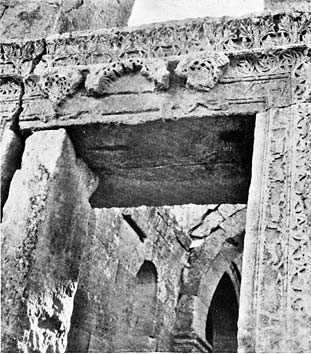
|
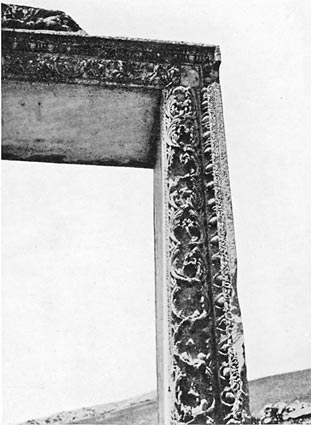
|
[ Illustrations opposite p.347 ]
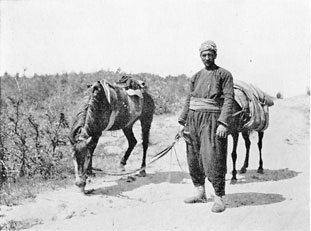
|
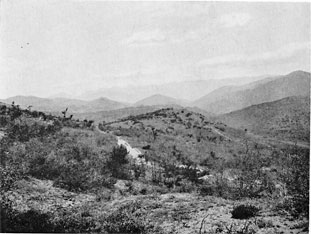
|
/ TOMARZA p.347 / the streets I was met by a young man who accosted me in French.
"Vous parlez français?" said he.
"Mais oui," said I.
"Vous parlez bien?" he continued.
"Très bien," I answered unblushingly and he was obliged to take my word for it, for when I inquired whether he were a native of Tomarza, he could not understand until I repeated the question in Turkish.
My next interlocutor was a boy who spoke English, which he had learnt, and learnt well, in an American college where he had taken his degree. He asked if he might know my name, and when I had obliged him in this particular, he begged that he might be told my object in coming to Tomarza. But I, being at the moment too busy with the ruins of the church to answer so many questions, replied that I had no object, and reduced him to a discomfited silence. The springs of action are different in American colleges.
We left Tomarza at ten o'clock and journeyed into the hills by way of Suvagen, which we reached at 12.40. Almost immediately after we had left the village, we entered a gorge, and our path climbed up through the pine-woods to Kokur Kayâ, a small yaila near the top of the pass known as Kara Bel. Here we pitched camp at five in the afternoon, close under the snow-wreaths that clung to the northern side of a rocky chain of peaks. Until sunset the clear fresh notes of a cuckoo filled the alp, and all that he had to say was worth hearing; but I wondered whether he enjoyed the society of his brother the kite, whose thin rippling cry dropped down from the rocks above him. I did not take my camp over the pass to Comana, but set out next day with Fattûh and a zaptieh and such simple provisions as might enable us to spend a night away from our tents if we found it necessary. Before we started I covenanted with the zaptieh, who was unusually pious, that prayers should be suspended for the day, the previous day's journey having been seriously upset by the occurrence of the 'asr (the hour of afternoon prayer), though every one knows that there is a special dispensation with regard to travellers. / p.348 / The long grassy pass opens on to a confused prospect of desolate mountains and hardly less deserted valleys; the gnarled and twisted pine-woods clinging to the rocks, the flowering hawthorn and regiments of yellow mullein that lined the lower course of the stream, gave to our road a memorable beauty, and if the going was not so good as might have been desired, why, we had seen worse. In the midst of these wild solitudes, five hours from Kokur Kayâ, we came upon a ruined shrine. It was a temple-mausoleum, and in this respect the true forerunner of the memorial churches of the Anatolian plateau (Fig. 226); nor did the connection between the Christian and the Pagan work cease here. The shallow engaged
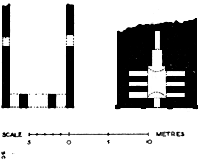
UPPER AND LOWER STOREYS. |
[ Illustrations opposite p.348 ]
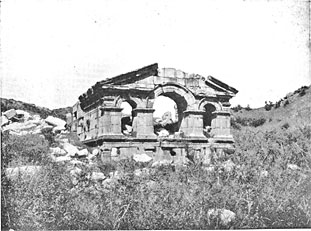
|
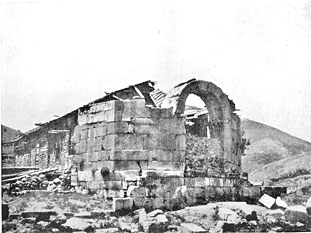
|
[ Illustrations opposite p.349 ]
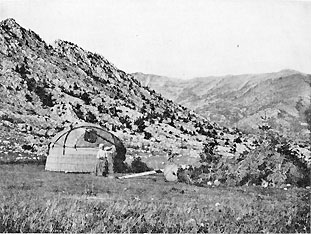
|
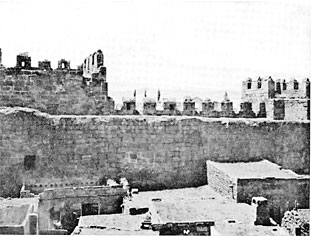
|
/ SHAHR p.349 / gardens planted with fruit-trees, but the streets and houses were no less ruined than the temples of the Great Goddess. The hot breath of massacre had passed down the smiling vale and left Shahr a heap of ashes. I found the inhabitants huddled together on a bluff where half-a-dozen of their dwellings had escaped destruction. A young school-master from the American college of Tarsus told me the story in my own tongue. He was himself a native of Shahr, and chance had brought him back to his home shortly before the outbreak at Adana and Tarsus. Of this disaster, which began upon April 14, the people of Shahr had received no information until, on April 20, the Kurds, Turks and Circassians from the neighbouring Moslem villages appeared in arms and announced that they did not intend to leave a single Christian alive. The villagers of Shahr had eighty rifles among them. Thus armed they defended the bluff, on which stand the ruins of the chief shrine of Ma, for nine days, at the end of which time tardy help arrived from 'Azîzîyeh. They had not lost a life, but they had been powerless to prevent the destruction of the village in the valley. Every house was looted and burnt; of the bazaars nothing remained but blackened foundations; the charred beams of the bridge had fallen into the stream, and the only wall that yet stood in the low ground was a splendid fragment of ancient masonry facing the river.
"Why," said I, gazing upon the ruin heaps that had once been the school-master's house, "did they spare the fruit-trees and the corn?"
"They thought that we should be dead before the corn was ripe," he answered, "and they meant to reap it for themselves. Also the fruit-trees they looked on as their own. Besides these we have nothing left, and we are so much troubled by hunger."
They were as much troubled by the thought that they could not offer me a fitting hospitality. The oda (the village guest-chamber) was in ashes, and the few houses on the bluff were crowded with women and children. But there was nothing to detain me. The ancient buildings had suffered with the modern; the inscribed stones and acanthus capitals, relics of a / p.350 / golden past, which had decked the streets of the bazaar, lay blackened and half buried among the ruins, and after I had made a brief survey of the site, I handed over to the schoolmaster the little money that was in my purse, and turned back across the hills.1
---------------------------
1 In the low ground there are remains of a theatre, a fine bit of stone wall decorated with good mouldings, and part of a vaulted brick building, possibly a gymnasium. All these are upon the left bank of the stream. The temple upon the bluff was converted at an early date into a church, which has long since fallen into decay, though it has been patched up in recent times by the Armenians (Fig. 228). Along the edge of the bluff there are remains of a columned portico. In the ruined bazaar I saw a couple of beautiful funnel capitals, cracked and broken by fire. They should probably be dated in the early sixth century. At the entrance of the valley that leads up to the Kara Bel are the ruins of a small temple with a finely carved doorway (Fig. 223).
Mr. Hogarth sends me the following note:—
Miss Bell has submitted to me five inscriptions found on a temple site at Comana Capp. They are, she thinks, unpublished, and certainly were not seen by me on either of my visits to Comana in 1890 or 1891. Miss Bell sent me good photographs of nos. 1 and 2; but for the others, I have only her hand-copies to go upon.
No. 1 is a commonplace epitaph, intended to be hexametrical; but the necessary proper names would not accommodate themselves to the metre, and the versifier has had to leave Il. 1 and 3 partly prose. In 1.2 he or the lapicide has made the mistake of leaving the e [Ed: 'e'] before hd [Ed: 'id'] unelided. The most interesting point in the inscription, the second name of the dedicator, is, unfortunately, obscured by a breakage of the surface. The lettering is very clear on the photograph except on the right edge.
No. 2 is broken top and right, and the names of the son and mother cannot be restored.
No. 3, the epitaph of a slave set up by his master, offers an instance of the distinction of slaves by the name of the master with a Roman gentile prefix. Either Aur. [Ed: Aur.] or Aili. [Ed. Aili.] is concealed in Miss Bell's copy of l.2. Another slave seems to have appropriated the grave afterwards for his wife, and added a note to that effect.
No. 4 is without points of interest. No. 5 adds to other Oriental names found at Comana Pharnaces and the name of his father, which, in Miss Bell's copy, reads Giris.
1. Altar-stela with wreaths in relief on the front and sides. The inscription is in careful lettering of about the 4th cent. A.D. Words are in some cases divided by points. Square and round forms are / p.351 / used indifferently, and ligature is frequent. Worn badly on right edge:—
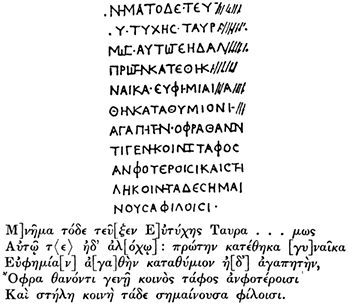

3. Altar-stela:—
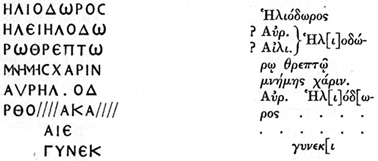
4. On the rock inside tomb:—


The dusk gathered about us as we climbed up to the pass, but the road that we had followed so gaily in the morning was full of darker shadows than those of night. "Nature, red in tooth and claw with ravine," cried out from riven crag and blasted pine; mountain and valley joined in her / EFFECTS OF MASSACRE p.351 / chorus, strophe to antistrophe. Mercilessly she creates and destroys; the fury of the storm, the sharp blade of the frost, the senseless passions of mankind, are alike of her ordering.
/ p.352 /
The ruins of Shahr were the sole evidence which I saw with my own eyes of the far-reaching havoc wrought by the outbreak at Adana, but before I reached Konia I had opportunity to judge of its lasting effect. In Cæsarea trade was paralyzed by the economic annihilation of the rich province of Cilicia, as well as by the fear of further disturbances. The massacres had struck terror into the heart of Moslem and of Christian; they extinguished for a time the new-born hopes of peace, and roused once more the hatred between creed and creed which the authors of the constitution had undertaken to allay. Every section of the community suffered from a destruction of confidence which is even more disastrous than the destruction of wealth, though the Armenians suffered incomparably the most. But the fact that they bore a penalty out of proportion to their fault does not acquit them of blame. They had helped to bring upon themselves the calamity that overwhelmed them; by wild oratory they had laid themselves open to the accusations of conspiracy which were brought against them; they had kindled the flames of discord by preaching in their churches the obligation of revenge. The criminal folly of their utterances stirred up vague alarms in the breasts of an ignorant and fanatical population, and from whatever side came the incitement to outrage, it came to ears sharpened by anxiety. But it must be remembered that in several instances catastrophe was averted by the prompt action of the officials who controlled the threatened districts. In Cæsarea the Mutesarrif, rather than allow a repetition of the Adana tragedy, ordered his soldiers to fire upon the Moslem crowd, who / 'ALI DÂGH p.353 / clamoured about the serai for arms on the plea that their lives were in danger from the Christians, and his uncompromising attitude brought the town to order; the Kâimmakâm of Eregli patrolled the streets night after night during a week of panic; the Mutesarrif of Kozan drove back the armed bands of Circassians who had marched down from the mountains bent on slaughter. Wherever it became evident that the government was not on the side of disorder, disorder was nipped in the bud, and I heard of one example where a handful of Turkish soldiers held in check many hundreds of Kurds, and the Christian village which they had assembled to destroy escaped untouched. I believe that no great massacre has taken place in Turkey without the encouragement of the central authority, or a passivity which amounts to connivance on the part of the local officials; a strong Vâlî backed by an enlightened government would keep peace in the most fanatical province of the empire.
On our way back to Tomarza we passed a large encampment of Avshars. The tents of these Turkish nomads are of a pattern which is common to nearly all the tribes of central Asia, but entirely different from that of the Arabs (Fig. 229). They are round, with a domed roof of felt supported on bent withes, and the sides are of plaited rushes over which a woollen curtain is hung when the nights are cold.1
---------------------------
We did not sleep a second night at Tomarza, but marched a couple of hours further upon the road to Cæsarea, and camped at the village of Mardîn, which lies in a cleft of the lava beds under the twin peaks of Mount Argæus. Next day we skirted the flanks of the great volcano, passing by the ruined Sarî Khân and under the small peak of 'Alî Dâgh, which is (so I was credibly informed by my zaptieh) nothing but a stray boulder dropped by 'Alî ibn abi Tâlib when he was engaged in helping the Prophet to pile up the huge mass of Argæus.2
---------------------------
Not only the geographical features of the land, but also the / p.354 / physical and moral qualities of the inhabitants of Cæsarea came under our consideration as we rode.
1 "Their houses are circular," says Marco Polo of the Tartars of inner Asia, "and are made of wands covered with felts": Yule's edition, Vol. I. p. 252.
---------------------------
2 Mârdin, 6.30; Yamachlî, to right, 7.30; Sarî Khân, 8.45; Ispileh, to right, 10.30; Talas, 11.30.
---------------------------
"If a serpent bites a man of Kaisarîyeh," observed Fattûh, "the serpent dies."
"Jânum!" exclaimed the zaptieh (who was not a Cæsarean). "My soul! they can outwit the devil himself. Have you not heard the tale?"
"I have not heard," said Fattûh.
"This it is," said the zaptieh. "Upon a day the devil came to Kaisarîyeh. 'Khush geldi,' said the people, 'a fair welcome,' and they showed him the streets and the bazaars of the city, the mosques and the khâns, all of them. When he was hungry they set food before him till he was well satisfied, but when he rose to depart, he looked for his cloak and belt and they were gone. The devil is not safe from the thieves of Kaisarîyeh."
"God made them rogues," said Fattûh.
"What can we do?" observed the zaptieh philosophically. "Dunya bîr, jânum—the world is all one."
"Great travelling they make," continued Fattûh. "In every city you meet them."
The zaptieh was ready with historic evidence on this head also.
"There was a man," said he, "who lived some time in Cæsarea, and having had experience of the people, he found them to be all pigs. Therefore he resolved to journey to the furthest end of the earth, that he might escape from them. And he went to Baghdâd, which is a long road."
"It is long," admitted Fattûh.
"And then he entered the bath and demanded a good hammâmjî to knead the weariness out of his bones. And the owner of the bath called out: 'Bring the lame Cæsarean!' Then said the traveller: 'A Cæsarean here and he lame!' and he fled from Baghdâd."
Fattûh is innocent of any sense of humour. "Oh Merciful," said he gravely.
I do not know whether it was the effect produced by these
[ Illustration opposite p.354 ]
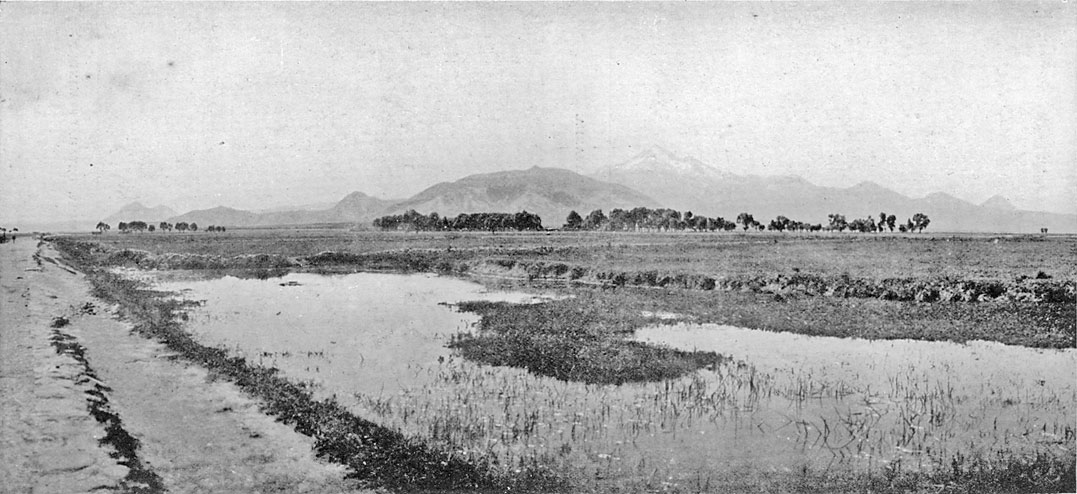
|
[ Illustrations opposite p.355 ]
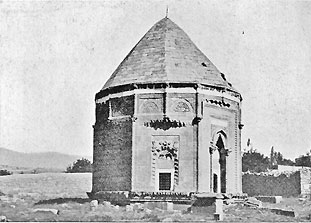
|
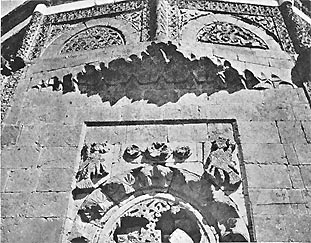
|
/ CÆSAREA p.355 / tales which prevented me from lodging in Kaisarîyeh, or whether the prospect of two days spent in the society of people of my own speech and civilization would not have proved too strong a temptation, even if the Cæsareans had shone with every virtue; at any rate I went no further than Talas, and there remained as a guest in the hospital of the American missionaries. And if I saw little of the famous city of Cæsarea, I passed many hours in the hospital garden at the feet of men and women whose words were instinct with a wise tolerance and weighted by a profound experience of every aspect of Oriental life.
Kaisarîyeh was the end of the caravan journey. In two days we had sold our horses ("One for us to sell and one for them to buy," said Fattûh), and packed our belongings.into the carts which were to take us to the railway at Ereglî. I rode down from Talas to conclude these arrangements and to visit the citadel which stands on Justinian's foundations. The interior is now packed with narrow streets, the houses being built partly of ancient materials (Fig. 230). The fragments of columns and the weather-worn capitals which are imbedded in the walls of the houses were derived either from the early Christian town which occupied the site of modern Kaisarîyeh, or from ancient Cæsarea, which lay upon the lower slopes of Mount Argæus. A few foundations outside the limits of the present town are all that remain of the Anatolian plateau, the birthplace of St. Basil, but the memory of the Seljuk conquerors, who gave it a fresh glory during the Middle Ages, is still preserved in many a decaying mosque and school.
We set out from Kaisarîyeh a diminished party, Hâjj 'Amr and Selîm having found work with a caravan of muleteers and returned with them across the mountains to Aleppo. The first day's drive took us round the foot of Argæus to Yeni Khân, a solitary inn, not marked in Kiepert, which lies two hours to the north of Karahisâr. The mighty buttresses of Argæus, rising out of the immense flats of the Anatolian plateau, are as imposing as the flanks of Etna rising from the / p.356 / sea, and its height, over 13,000 feet, is scarcely less from base to summit than that of the Sicilian volcano.1
---------------------------
The second day brought us to a khân by the roadside, half-an-hour from the village of Andaval; upon the following morning we reached, after three-quarters of an hour's drive, the church of Constantine, of which the foundation is attributed by legend to the Empress Helena,2
---------------------------
and in two hours more we came to Nigdeh, where I halted for a few hours to see the Seljuk mosques and tombs for which the town is famed. Of these the most beautiful is the so-called mausoleum of Havanda, the wife of 'Ala ed Din.3
---------------------------
It is in ground plan an octagon, but above
Fig. 232.—TOMB OF HAVANDA.
---------------------------
and / p.358 / since the mullah was standing under the carved gateway, I stopped to bid him a good-evening. In the tomb chamber that opens out of the cloistered courtyard I remembered to have seen fragments of a fine inscription of blue tiles: scarcely a tile was left upon the walls and I knew how they had vanished, for I had found one of them in the hands of a Konia dealer and bought it from him. This incident I related to the mullah.
1 The plateau is here about 3,500 feet above sea level.
---------------------------
2 It has been well published by Rott: Kleinasiatische Denkmäler, p. 103.
---------------------------
3 'Ala ed Din reigned from 1219 to 1236, but the tomb is dated by an inscription in the year 1344.
---------------------------
the windows the number of faces is doubled, the additional angles being built over projecting brackets, finely worked with stalactite ornaments (Figs. 232 and 233). The spandrils above the windows are decorated with pairs of sphinxes (Fig. 234), and the door is framed in a delicate tracery of lace-like patterns. Beyond Bor we came into a well-known country dominated by the twin peaks of Hassan Dâgh, the Lesser Argæus, which I greeted with a respect mingled with the familiarity born of an intimate acquaintance with its rocks. Three hours from Nigdeh we reached Emîr Chiflik, where there is a khân unnamed by Kiepert, and next morning we drove into Bulgurlû, the present terminus of the Baghdâd railway. But the art of modern travel accords ill with the habits of the East; the / KARA DÂGH p.357 / baggage wagon missed the daily train and we were obliged to wait for it at Ereglî.
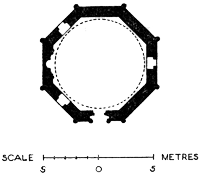
"Your Excellency does not wish to see the pictures of the Benî Hît?" said Fattûh suspiciously as we stepped out upon the platform. We had never before passed through Ereglî without visiting the great Hittite relief in the gorge of Ivrîz. But I reassured him: we had seen enough.
One more expedition lay, however, between us and Konia. It was to be accomplished in light order; indeed, we might have ridden up to the Kara Dâgh without possessions, for there was no man in all the mountain who would not have been proud to offer us a lodging. Fattûh and I shone there with a reflected glory that radiated from the Chelabî, whose fame is not confined to the Kara Dâgh, though few perhaps of his colleagues in the Scottish Academe which he adorns would recognize him under his Anatolian title. Had we not spent weeks under his direction in grubbing among old stones, to the delight and profit of all beholders? Had we not consumed innumerable hares and partridges at twopence a head, and offered a sure market for yaourt and eggs? And when the regretted hour of departure arrived, what store of empty tins and battered cooking pots was left behind to keep our memory green! Our renown extended even to Karamân, where we alighted from the train on the following evening. The khânjî was a trusted friend, the shopkeepers pressed gifts of rose jam upon us, and when the hiring of horses presented a difficulty, I had only to step out into the streets and explain our needs to the first acquaintance whom I met. He happened to be a hammâl (a porter) who had done a couple of days' work for us in the Kara Dâgh, and he was intimate with an arabajî (a carriage driver), who would without doubt place his horses at our disposal; and if I would come in and drink a cup of coffee the matter should be settled. I accepted the invitation and was introduced triumphantly to the hammâl's wife: "This is the maid I told you about — she who worked with the Chelabî." On our way back to the khân we chanced to pass by the exquisite Khâtûnyeh Medresseh,1
1 It was built in 1381–2 by the wife of 'Ala ed Din, Prince of Karamân. See Sarre: Denkmäler Persischer Baukunst, p. 135.
---------------------------
"You did very wrong," said he. "You have stolen one of our tiles and carried it away."
"I did not steal it," I pleaded weakly. "I found it at Konia."
"It is all one," he replied. "You should give it back."
But as we went out through the cloister I noticed that the columns which supported it were double columns of a type peculiar to Christian architecture. They had in all probability been removed from a church.
"Mullah Effendi," said I, "we are equal. I have taken a tile out of your Moslem tomb, and you the columns from our Christian church."
The mullh's indignation vanished in a flash. "Âferîn!" he cried, with a jolly laugh. "Bravo!" and he clapped me on the back.
The hammâl's confidence in the arabajî had not been misplaced; we set out next morning for the Kara Dâgh, and every mile was full of delightful reminiscence. The yellow roses dropped their petals in familiar fashion over the mountain path, mullein and borage spread their annual carpet of blue and gold between the ruins, and the peak of Mahalech, on which I had found a Hittite inscription and a Christian monastery, stood guardian as of old, over the green cup wherein had lain an ancient city. The sturdy Yuruks came striding down from their high yailas to bid us a joyful coming and a slow departure; many were the greetings that passed round the camp fire, and it was well that Fattûh had laid in a good provision of coffee at Karamân.
So on a hot morning we struck our last camp and rode down the northern slopes of the mountain to rejoin the railway / KONIA p.359 / by which we were to travel to Konia. And as we crossed the level plain Fattûh observed with satisfaction:
"The cornland has increased since two years ago. Effendim, there is twice as much sown ground."
"Praise God!" said I. "It is the doing of the railway."
"Wherever it passes the corn springs up," said Fattûh. "Mâshallah! Konia will become a great city."
"It has grown in our knowledge," said I. "But this year we shall find it much changed, for all our friends have left."
"Where have they gone?" inquired Fattûh.
"Riza Beg is in Salonica," said I, mentioning one who had eaten out his heart in exile for ten weary years. "He has gone back to his wife and child."
"He would make haste to join them," assented Fattûh.
"And Mehmet Pasha is in Constantinople. I saw his name among those who helped to depose the Sultan."
"He has risen to high honour," said Fattûh. Mehmet Pasha was another of the proscribed.
"And Suleimân Effendi is deputy for Konia, where he was so long in exile. Oh Fattûh, we shall be strangers there now that our friends have gone."
"Your Excellency will meet them in other cities," said Fattûh. "And they will be free men."